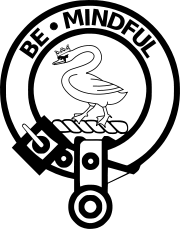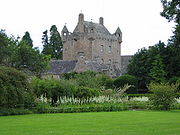
Clan Campbell of Cawdor
Encyclopedia

Scottish Highlands
The Highlands is an historic region of Scotland. The area is sometimes referred to as the "Scottish Highlands". It was culturally distinguishable from the Lowlands from the later Middle Ages into the modern period, when Lowland Scots replaced Scottish Gaelic throughout most of the Lowlands...
Scottish clan
Scottish clan
Scottish clans , give a sense of identity and shared descent to people in Scotland and to their relations throughout the world, with a formal structure of Clan Chiefs recognised by the court of the Lord Lyon, King of Arms which acts as an authority concerning matters of heraldry and Coat of Arms...
. While the clan is recognised by the Standing Council of Scottish Chiefs
Standing Council of Scottish Chiefs
The Standing Council of Scottish Chiefs is the organisation of the Chiefs of many prominent Scottish Clans. The SCSC is the definitive and authoritative body for information on the Scottish Clan System.-History:...
, the clan does not have a clan chief
Scottish clan chief
The Scottish Gaelic word clann means children. In early times, and possibly even today, clan members believed themselves to descend from a common ancestor, the founder of the Scottish clan. From its perceived founder a clan takes its name. The clan chief is the representative of this founder, and...
recognised by the Standing Council of Scottish Chiefs. Also, because the clan does not have a clan chief recognised by the Lord Lyon King of Arms
Lord Lyon King of Arms
The Lord Lyon King of Arms, the head of Lyon Court, is the most junior of the Great Officers of State in Scotland and is the Scottish official with responsibility for regulating heraldry in that country, issuing new grants of arms, and serving as the judge of the Court of the Lord Lyon, the oldest...
it is considered an armigerous clan
Armigerous clan
An armigerous clan is a Scottish clan, family or name which is registered with the Court of the Lord Lyon and once had a chief who bore undifferenced arms, but does not have a chief currently recognized as such by Lyon Court...
.
In 1510, Muriel, daughter of John, 7th Thane of Caddell (or Calder), married Sir John Campbell, third son of the 2nd Earl of Argyll. From 1524 to 1546, Sir John Campbell of Caddell lived at Caddell Castle, until his death. After Muriel's death in 1573, the Thanedom was resigned in favour of her grandson, John Campbell. In the 17th century, Sir John Campbell of Caddell sold Croy and disposed of Ferintosh to Lord Lovat, in order to buy the Isle of Islay. Islay
Islay
-Prehistory:The earliest settlers on Islay were nomadic hunter-gatherers who arrived during the Mesolithic period after the retreat of the Pleistocene ice caps. In 1993 a flint arrowhead was found in a field near Bridgend dating from 10,800 BC, the earliest evidence of a human presence found so far...
was held by the Campbells of Caddell from 1612-1726 when it was bought by Daniel Campbell of Shawfield. Sir John Campbell, 8th of Caddell
John Campbell of Cawdor
John Campbell of Cawdor , was a British politician. He was the Member of Parliament for Pembrokeshire, Inverness Burghs and Corfe Castle.He was also the Lord Commissioner of the Admiralty and Lord Commissioner of the Treasury.-References:...
, married Mary, eldest daughter of Lewis Pryce (or Pryse) of Gogerddan in Cardiganshire
Ceredigion
Ceredigion is a county and former kingdom in mid-west Wales. As Cardiganshire , it was created in 1282, and was reconstituted as a county under that name in 1996, reverting to Ceredigion a day later...
. Campbell of Cawdor died in 1777 and was succeeded by his son, Pryse Campbell of Caddell, who was a MP for Cromartyshire and Nairnshire. His son, John, was made Lord Caddell of Castlemartin in 1797. On his death in 1821, he was succeeded by his son, John Fredrick Campbell, 1st Earl of Cawdor
John Campbell, 1st Earl Cawdor
John Frederick Campbell, 1st Earl Cawdor was a British earl and MP.He was born the son of John Campbell, 1st Baron Cawdor and Lady Caroline Howard and educated at Eton College and Christ Church, Oxford, graduating BA in 1912...
. From the 1st Earl of Cawdor descend the Earls of Cawdor. (Source: records of the Scottish Privy Council, 1613–1616)
The name "Cawdor" is the English pronunciation and spelling of the ancient and original name of Caddell. In the lowlands, the name was pronounced Calder, so that if someone moved from the highlands to Edinburgh, their name would change from Caddell to Calder. In the early 19th century, Lord John Campbell of Caddell was residing in England and changed the name of the castle, town and clan overnight so that it would match the Shakespearian designation (reference: Cawdor Historical Society).

Clan Campbell
Clan Campbell is a Highland Scottish clan. Historically one of the largest, most powerful and most successful of the Highland clans, their lands were in Argyll and the chief of the clan became the Earl and later Duke of Argyll.-Origins:...
, Torquhil Campbell, 13th Duke of Argyll
Torquhil Campbell, 13th Duke of Argyll
Torquhil Ian Campbell, 13th and 6th Duke of Argyll , known as Earl of Campbell before 1973 and as Marquess of Lorne between 1973 and 2001, is a Scottish Peer...
. Frank Adam and Thomas Innes of Learney
Thomas Innes of Learney
Sir Thomas Innes of Learney, GCVO, WS was Lord Lyon from 1945 to 1969, after having been Carrick Pursuivant and Albany Herald in the 1930s. He was a very active Lord Lyon, strongly promoting his views of what his office was through his writings and pronouncements in his Court. In 1950, he...
, in their The Clans, Septs & Regiments of the Scottish Highlands, listed several septs
Sept (social)
A sept is an English word for a division of a family, especially a division of a clan. The word might have its origin from Latin saeptum "enclosure, fold", or it can be an alteration of sect.The term is found in both Ireland and Scotland...
for Clan Campbell of Cawdor. These were: Caddell and Calder. Adam and Innes of Learney also wrote that the Campbells of Cawdor were described as "de Cadella".
Names and Spellings of Names connected with Clan:
Associated Names and Septs (with spelling variations):
Cadall Caddel Caddell Cadder Cadell Cadella Caldaile Caldell Calder Caldor Cambal Cambale Cambel Cambele Cambell Cambelle Camble Cammell Campbele Campbell Campbill Campble Cattal Cattall Cattell Cattle Cauder Caudle Caulder Cawdale Cawdor Chambelle Cowdale Kambail Kambaile Kambayl Kumpel O'Docharty Torie Torrie Torry
See also

- Clan CampbellClan CampbellClan Campbell is a Highland Scottish clan. Historically one of the largest, most powerful and most successful of the Highland clans, their lands were in Argyll and the chief of the clan became the Earl and later Duke of Argyll.-Origins:...
- Clan CalderClan CalderClan Calder is a Highland Scottish clan. The clan does not currently have a chief therefore it is considered an Armigerous clan.-Origins of the Clan:...
- Cawdor CastleCawdor CastleCawdor Castle is a tower house set amid gardens in the parish of Cawdor, approximately 10 miles east of Inverness and 5 miles southwest of Nairn in Scotland, United Kingdom. It belonged to the Clan Calder. It still serves as home to the Dowager Countess Cawdor, stepmother of Colin Robert Vaughan...
- Earl of Cawdor
- Armigerous clanArmigerous clanAn armigerous clan is a Scottish clan, family or name which is registered with the Court of the Lord Lyon and once had a chief who bore undifferenced arms, but does not have a chief currently recognized as such by Lyon Court...

